
The Earth-Moon distance is vast, yet it pales in comparison to the vastness of space.
Space is known to be immense, which is why astronomers use different units of measurement than what we are accustomed to. While kilometers are still useful when measuring the distance to the Moon (384,000 km), they become less practical when measuring the distance to Pluto, which is approximately 4,250,000,000 km. To simplify recording and calculations, astronomers employ alternative units of distance measurement, which are discussed below.
Astronomical unit
The astronomical unit (a.u.) is the smallest unit of measurement in astronomy. Originally, it was defined as the distance from the Earth to the Sun, which is the average distance between the surface of our planet and the Sun. This measurement was most suitable for studying the structure of the solar system in the 17th century. The exact value of the astronomical unit is 149,597,870,700 meters. Nowadays, it is commonly used for calculations involving relatively short distances, such as within the solar system or other planetary systems.
What is a Light-year?
The light-year is a unit of length used in astronomy that represents the distance that light travels in a vacuum over the course of one terrestrial, Julian year. It is also a measure of the distance at which gravitational forces have no effect on the trajectory of light. In numerical terms, one light-year is approximately equal to 9,460,730,472,580 kilometers or 63,241 astronomical units (a.u.). While the light-year is primarily utilized in popular science literature to provide a sense of scale on a galactic level, it is not commonly used in scientific works due to its inherent inaccuracy and inconvenience.
Resources about the subject

Parsec
The most convenient and practical unit of distance measurement for astronomical calculations is known as a parsec. In order to understand its physical significance, it is important to consider a phenomenon called parallax. Parallax refers to the apparent change in distance between two distant objects when an observer moves. When it comes to stars, this phenomenon manifests itself as a slight change in the visual position of nearby stars as the Earth orbits around the Sun, while distant stars remain relatively fixed in the background. The change in a star’s position as the Earth shifts by one radius of its orbit is known as annual parallax, which is measured in angular seconds.
So, a star that is one parsec away has an annual parallax of one angular second. That’s why a parsec is defined as the distance to a star with a parallax of one arcsecond. The term “parsec” comes from combining the words “parallax” and “second”. In terms of measurement, one parsec is equal to 3.0856776-10 16 meters or 3.2616 light-years. To put it in perspective, one parsec is approximately equivalent to 206,264.8 astronomical units (a.u.).
Laser location and radar methods
These two advanced techniques are utilized for measuring the precise distance to an object within the solar system. The process is as follows: a powerful radio transmitter emits a focused radio signal towards the target object. Subsequently, the object reflects the received signal and sends it back to Earth. By calculating the time it takes for the signal to travel this path, the distance to the object can be determined. The accuracy of radar methods is limited to a few kilometers. On the other hand, laser location employs a light beam instead of a radio signal, enabling the calculation of the object’s distance using similar computations. Laser location achieves an impressive level of accuracy, reaching fractions of a centimeter.
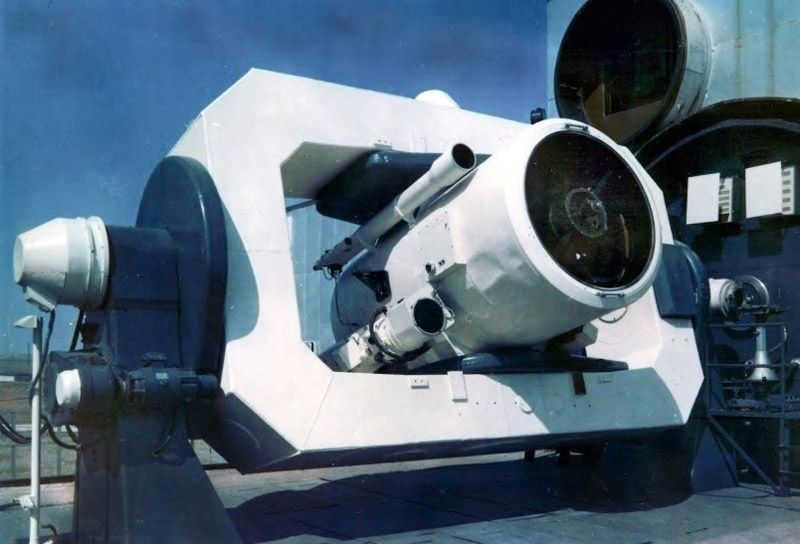
TG-1 telescope, located at the Sary-Shagan test site, is used for the LE-1 laser locator.
Using the trigonometric parallax method to measure distance
The trigonometric parallax method is a simple way to measure the distance to faraway objects in space. It is based on basic geometry principles. First, a baseline is drawn between two points on Earth’s surface. Then, an object in the sky is selected as the vertex of a resulting triangle. Next, the angles between the baseline and lines drawn from the selected points to the object in the sky are measured. By knowing the side and two adjacent angles of the triangle, it is possible to calculate all other elements of the triangle.
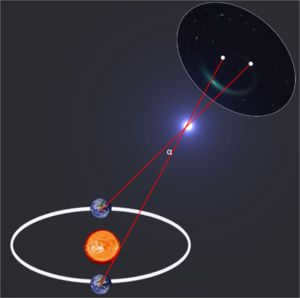
This approach is not very practical for studying objects from Earth because the Earth’s atmosphere interferes with determining the annual parallax of objects located more than 100 parsecs away.
However, in 1989, the European Space Agency launched the Hipparcos space telescope, which enabled the determination of stars up to 1000 parsecs away. By analyzing the collected data, scientists were able to create a three-dimensional map showing the distribution of these stars around the Sun. In 2013, ESA launched another satellite called Gaia, which has 100 times better measurement accuracy. This allows for the observation of all the stars in the Milky Way. If human eyes had the same level of accuracy as the Gaia telescope, we would be able to see the diameter of a human hair from a distance of 2,000 km.
The technique of using standard candles
The technique of using standard candles is employed to calculate the distances to stars in distant galaxies and the distances to those galaxies themselves. As we are aware, the further the light source is positioned from the observer, the less bright it appears to the observer. In other words, the brightness of a light bulb at a distance of 2 meters will be four times lower than at a distance of 1 meter. This concept serves as the foundation for measuring the distance to objects through the standard candle method. Therefore, by drawing a comparison between a light bulb and a star, we are able to compare distances to light sources with known luminosities.
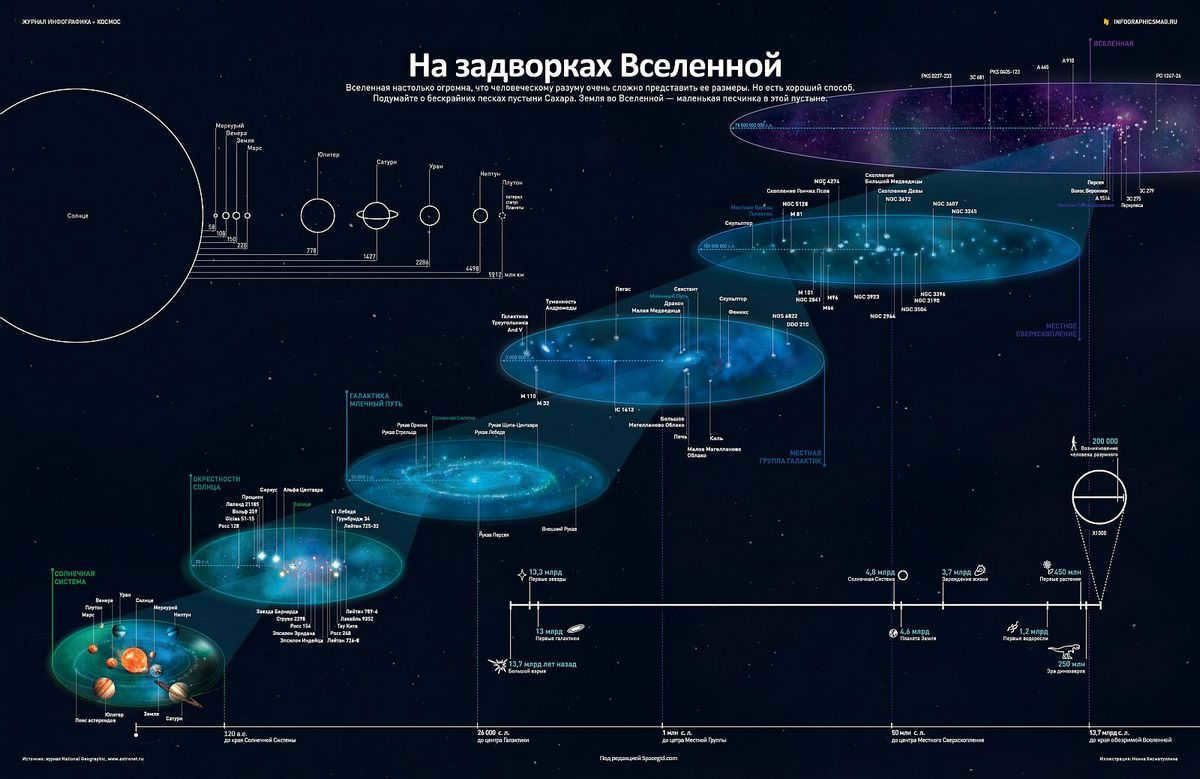

The scope of the Cosmos that has been investigated through contemporary techniques is truly awe-inspiring. Take a look at the full-size infographic.
Standard candles in astronomy refer to objects whose luminosity, or source power, is known. These objects can take the form of any type of star. Astronomers are able to determine the luminosity of a star by measuring its surface temperature, which is determined by the frequency of its electromagnetic radiation. With this temperature information, astronomers can then determine the spectral class of the star and locate its position on the Hertzsprung-Russell diagram. By having knowledge of the luminosity values and measuring the brightness, or apparent magnitude, of the star, astronomers are able to calculate the distance to the star. Utilizing standard candles provides a useful tool for estimating the distance to the galaxy in which the star is located.
Nevertheless, this approach requires a significant amount of manual work and does not offer high precision. As a result, astronomers find it more practical to utilize cosmic objects with distinct characteristics, whose luminosity is already known, as their standard candles.
Exceptional standard candles
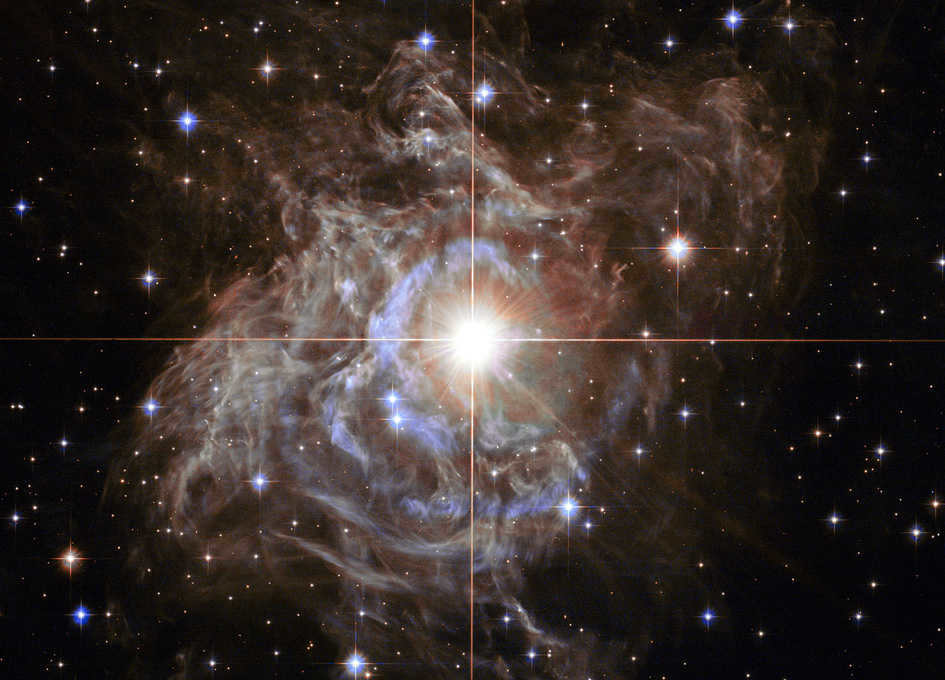
Cepheids, which are variable pulsating stars, are the most commonly used standard candles. Astronomers have discovered that Cepheids have an additional characteristic – their pulsation period, which can be easily measured and corresponds to a specific luminosity.
By observing these variable stars, scientists can measure their brightness and pulsation period, and therefore determine their luminosity. This allows them to calculate the distance to the stars. When a Cepheid is found in another galaxy, it becomes possible to accurately and easily determine the distance to that galaxy. This is why Cepheids are often referred to as the “beacons of the universe.”
While the cepheid technique is known for its high accuracy within a range of 10,000,000 pc, it is worth noting that it can still have an error rate of up to 30%. In order to enhance the precision of measurements, it would be necessary to gather a significant number of cepheids within the same galaxy. However, even with this approach, the margin of error is reduced to a minimum of 10%. This is primarily due to the inherent imprecision of the period-luminosity relationship.
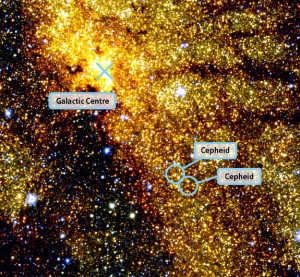

In addition to Cepheids, other types of stars that vary in brightness with known period-luminosity relationships can be utilized as standard candles, and for measuring vast distances, supernovae with known luminosity can be employed. A method that closely approximates the accuracy of the Cepheid method involves the use of red giants as standard candles. It has been discovered that the brightest red giants possess an absolute stellar magnitude within a sufficiently narrow range, making it possible to calculate their luminosity.
Distances represented in numbers
Distances within the solar system:
- 1 astronomical unit (a.e.) is equivalent to the distance from the Earth to the Sun, which is approximately 500 seconds or 8.3 minutes.
- 30 astronomical units (a.u.) is the distance from the Sun to Neptune, which is approximately 4.15 light hours.
- 132 astronomical units (a.e.) is the distance from the Sun to the Voyager 1 spacecraft, which was observed on July 28, 2015. This spacecraft is the farthest man-made object.
Distances within the Milky Way and beyond:
- 1.3 parsecs (equivalent to 268,144 astronomical units or 4.24 light years) is the distance from the Sun to Proxima Centauri, the nearest star to us.
- 8,000 parsecs (equivalent to 26,000 light years) is the distance from the Sun to the center of the Milky Way.
- 30,000 parsecs (equivalent to 97,000 light years) is the approximate diameter of the Milky Way.
- 770,000 parsecs (equivalent to 2.5 million light years) is the distance to the nearest large galaxy, the Andromeda Nebula.
- The Universe is almost homogeneous at a scale of 300 trillion parsecs.
- The observable Universe extends up to 4 quadrillion parsecs (4 gigaparsecs), which is the distance that light recorded on Earth has traveled. Taking into account the expansion of the Universe, the objects that emitted this light are now situated 14 gigaparsecs away (equivalent to 45.6 billion light years).
Greetings, esteemed readers of the KtoNaNovenkogo.ru blog. No doubt, all of you are familiar with the concept known as a light year. The value of this concept is quite fascinating.
Light-years are used to measure distance, not time or days. According to the International Astronomical Union, 1 light-year is equivalent to 9,460,730,472,580,800 meters (approximately 9.461 billion kilometers).
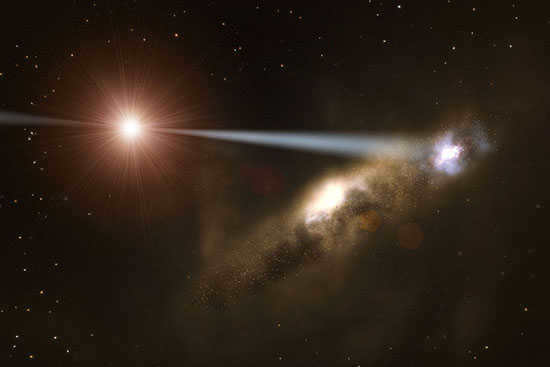
What is the purpose of this particular measurement unit? The enormity of the Universe makes it nearly impractical to employ meters and kilometers, as the resulting numbers would be astronomical. Consequently, a unit of measurement was established based on the distance traveled by a beam of light within a specific timeframe.
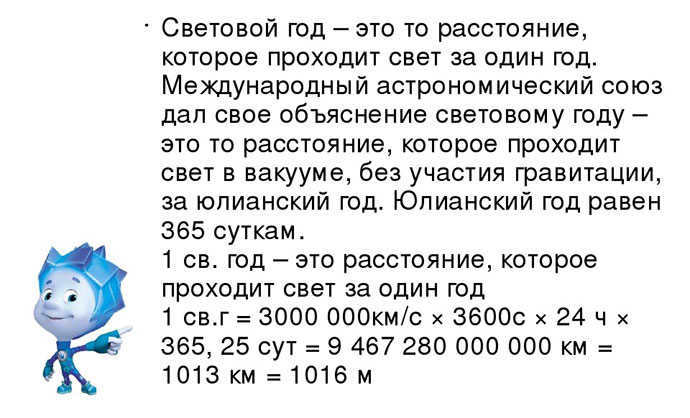
Let’s consider an example of a man going to the store. He has to cover a distance of two kilometers. However, his speed will vary throughout the journey. Initially, he may walk briskly, but eventually, he may get tired or encounter some distractions like tying his shoelace or meeting an acquaintance, causing him to slow down and walk at a leisurely pace.
On the contrary, a light beam is much more disciplined. It maintains a constant speed throughout its path, regardless of the conditions. Whether it’s a vacuum or any other medium, light travels at the same speed without any fatigue, deceleration, or acceleration.
The distance covered by light in a minute is referred to as a light minute, while in an hour it becomes a light hour, and so on. The largest distances in the universe are measured in light-years.
Discovering the Speed of Light
In ancient times, it was believed that light traveled instantaneously through space. However, Galileo Galilei was the first to question this assumption, although he was unable to prove it scientifically. The first person to successfully measure the speed of light was Danish astronomer Olaf Remer in 1676. His calculations, by today’s standards, were not very precise, estimating the speed at 214,000 km/s.
Over time, these measurements were refined. In 1728, English scientist James Bradley determined a value of 301,000 km/s, while French physicist Armand Fizeau, in 1849, established the speed of light as 315,000 km/s. Finally, Frenchman Leon Foucault achieved the closest estimate yet, measuring the speed at 298,000 km/s.
Light-year: A Closer Look
To avoid confusion when dealing with space measurements, let’s break it down into specific numbers:
1 light-year is equivalent to:
- 31,557,600 light-seconds;
- 525,960 light-minutes;
- 8,766 light-hours;
- 365.25 light-days;
- 9,460,730,472,580,800 meters;
- 63,241.077 astronomical units (a.u.).
For those who prefer kilometers, here are the corresponding figures:
- In 1 light-second, light travels a distance of 299,792,458 kilometers;
- In 1 light-minute, it reaches an incredible speed of 17,987,547.48 kilometers;
- In 1 light-hour, the beam covers a staggering 1,079,252,848.8 kilometers;
- 25,902,068,371.2 kilometers in 1 light-day;
- In 1 light-week – 181,314,478,598.4 kilometers;
- Traveling a distance of 1 light month would be equivalent to covering approximately 788,394,206,048.4 kilometers;
- If we were to travel a distance of 1 light year, it would be equivalent to covering about 9,460,730,472,580.8 kilometers.
Exploring Outer Space
The approximate distance from the Earth to the Moon is 380,000 kilometers. If a beam of light were to travel this distance, it would take approximately 1.3 seconds. On the other hand, if we were to travel from Earth to the Sun, which is about 150 million kilometers away, it would take a little over 8 minutes for light to cover that distance. To be more precise, it would take 8 minutes and 18 seconds. That’s enough time for someone to enjoy a cup of coffee.
Currently, traveling at the speed of light is still not possible in reality (except in science fiction movies). In reality, it would encounter significant friction and obstacles. However, let’s imagine for a moment that we possess a spacecraft capable of traveling at the speed of light. In that case, traveling between the planets of our solar system would be as simple as hopping into a taxi or shuttle bus.
It would take approximately 2 minutes to cover a distance of 40 million kilometers to reach Venus. Similarly, it would take around 3 minutes to travel 56 million kilometers to reach Mars. On the other hand, it would take approximately 4.5 minutes to cover a distance of 77 million kilometers to reach Mercury. However, the trip to Jupiter, which is approximately 587 million kilometers away, would take around 32 minutes.
Let’s venture even further into space. To reach Saturn, which is approximately 1.2 billion kilometers away, it would take just over an hour. Uranus, which is approximately 2.5 billion kilometers away, would take a little over two hours to reach. But if you’re willing to wait for four years, you can embark on a journey to the edge of the solar system, known as the Oort cloud, where you will have the opportunity to witness billions of comets.
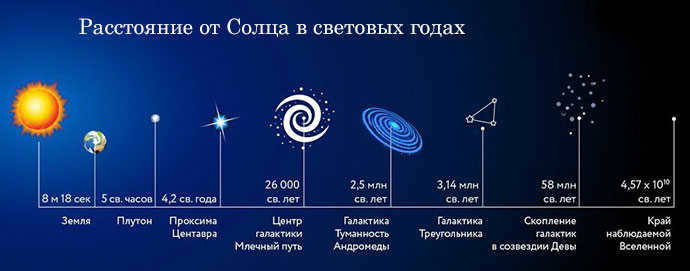
*click on the picture to open it full size in a new window
The distance to the nearest star system. – Alpha Centauri is slightly more than four light-years away.. If you were to travel there using a conventional rocket, with a velocity of 16.7 kilometers per second, it would take approximately 78,000 years to complete the journey.
A few additional numbers.
The celestial bodies we observe in the expanse above us are located at distances that can be measured in tens or even hundreds of light years. As for the core of our galaxy, known as the Milky Way, it spans an impressive distance of 26 thousand light years. The Andromeda Nebula, on the other hand, is located at a staggering distance of 2.5 million light years. Furthermore, the edge of the Universe is estimated to be approximately 14 billion light years away..


It is true that calculating such vast distances in kilometers would be a challenging task. The figures would be astronomical. Hence, astronomers have devised a different unit of measurement – light years – to quantify cosmic distances.
Fascinating trivia

For instance, if a star in the Orion constellation, located 495 to 640 light years away, were to explode, the light from that event would reach Earth in approximately 500-600 years. This means that, hypothetically, we could witness the light from a star that has already died during the time of Ivan the Terrible.
Best of luck to you! We hope to see you again soon on the KtoNaNovenkogo.ru blog.
This article falls under the following categories:
Please leave your comment or feedback below.

The measurement of cosmic distances can be challenging using standard units like meters and kilometers, which is why astronomers rely on alternative units. One such unit is the light-year.
Many enthusiasts of science fiction are familiar with this concept, as it frequently appears in movies and books. However, not everyone comprehends the exact definition of a light-year. In fact, some individuals mistakenly associate it with the conventional annual measurement of time.
What does the term “light year” mean?
Contrary to popular belief, a light year is not a measure of time, but rather a measure of distance used in the field of astronomy. It represents the distance that light travels in the span of one year.
The light year is commonly employed in astronomy textbooks and sci-fi literature to denote distances within our solar system. However, for more accurate mathematical computations, the parsec is often utilized as the fundamental unit of measurement.

The concept of the light-year in astronomy originated from the advancements in stellar studies and the necessity for using units of measurement that are appropriate for astronomical distances. The term was introduced a few years after the successful measurement of the distance between the Sun and the star 61 Swan in 1838.
Originally, the light-year was defined as the distance that light travels in one tropical year, which is equivalent to a full cycle of seasons. However, since 1984, the light-year has been based on the Julian year, which consists of 365.25 days.
To calculate the light year, scientists initially had to establish the velocity of light. In the past, astronomers held the belief that the transmission of light through space occurred instantaneously. However, during the 17th century, this assumption started to be questioned.
It was Galileo Gallilei who first made an attempt at these calculations. He decided to determine the time it took for light to travel a distance of 8 kilometers. Unfortunately, his research did not yield successful results. It wasn’t until 1728 that James Bradley managed to calculate an approximate value, where he arrived at a speed of 301 thousand km/s.
How fast does light travel?
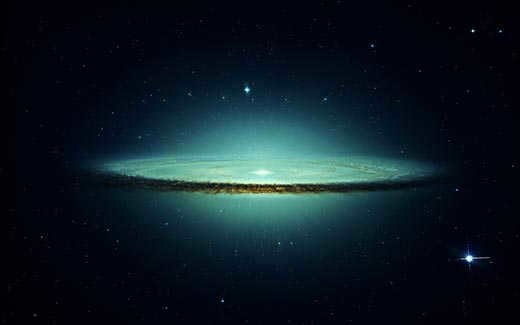
Although Bradley’s calculation was fairly accurate, it was not until the 20th century that the exact speed could be determined. Modern laser technology was utilized for this purpose. Advanced equipment enabled calculations to be made with a correction for the refractive index of light rays. As a result, the value was determined to be 299,792,458 kilometers per second.
It is worth mentioning that astronomers still use these figures today. Simple calculations in the past helped accurately establish the time it takes for light rays to orbit the Earth without being affected by gravitational fields.
While the distance covered by light is not comparable to the distances on Earth, it is still used in calculations because people are accustomed to thinking in terms that are familiar to them.
What exactly is a light-year?
If we consider that a light-second is equivalent to 299,792,458 meters, it becomes simple to conclude that light travels 17,987,547,480 meters in a minute. This information is commonly used by astrophysicists to measure distances within planetary systems.
In order to study celestial bodies on a universal scale, it is much more practical to use the light-year as a unit of measurement. This is equal to 9.460 trillion kilometers or 0.306 parsecs. Interestingly, the observation of cosmic bodies is the only circumstance in which an individual can witness the past.
Illustrations of distances measured in light-years
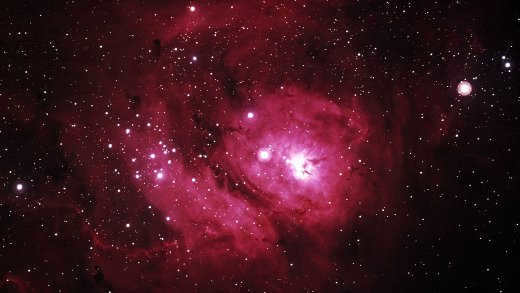
Astronomers have been able to measure the distance to various celestial bodies by calculating the speed of light. For instance, the distance from Earth to the Moon is equivalent to 1.3 light seconds. Proxima Centauri, on the other hand, is located 4.2 light years away, while the Andromeda Nebula is situated 2.5 million light years from us.
The distance between the Sun and the center of our galaxy spans approximately 26 thousand light years. As for the distance between the Sun and Pluto, it is about 5 light hours.

Have you ever wondered why astronomers refrain from utilizing the light-year as a unit of measurement when calculating the vast distances between celestial bodies?
A Brief Overview of the Light-year
A light-year serves as a widely recognized unit of measurement for distances in outer space. It is commonly employed in popular astronomy literature, yet is infrequently utilized in professional astrophysics, primarily to ascertain distances to remote celestial bodies. The rationale behind this is rather straightforward: if one were to express the distance to distant objects in the Universe in light-years, the resulting figure would be so immense as to render it impractical and unwieldy for physical and mathematical computations. Consequently, professional astronomers opt to employ the parsec as their preferred unit of measurement, as it proves far more convenient when executing intricate mathematical calculations.
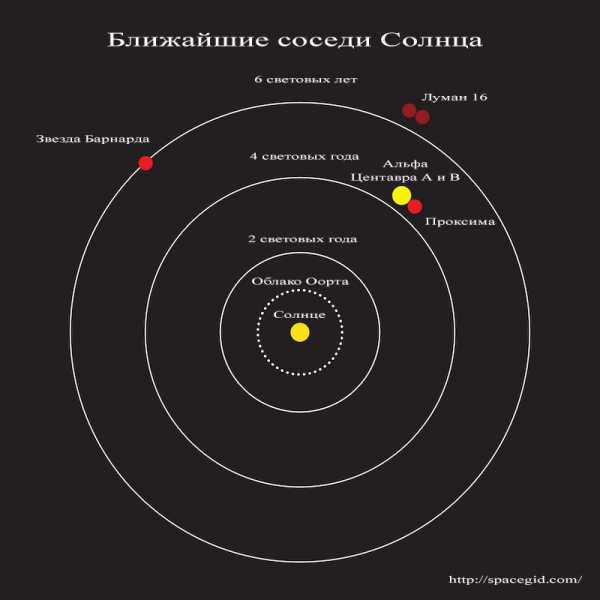
The nearest stars to the Sun
In any astronomy textbook, we can find the definition of the term “light-year”. A light-year is the measurement of the distance that a ray of light travels in the span of one Earth year. This definition may be satisfactory for a beginner, but an expert in cosmology would argue that it is not comprehensive. They would point out that a light-year represents not only the distance that light travels in a year, but rather the distance that a beam of light travels in 365.25 Earth days through a vacuum, unaffected by magnetic fields.
A light-year is equivalent to 9.46 trillion kilometers. This is the precise distance that a beam of light covers in the duration of one year. But how did astronomers arrive at such a precise definition of the path of light? We will delve into that topic below.
The method used to calculate the speed of light
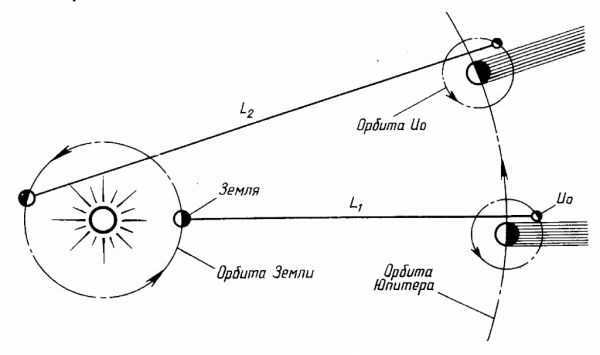
In ancient times, people believed that light traveled instantly throughout the universe. However, in the 17th century, scientists began to question this idea. Galileo was one of the first to doubt this belief. He attempted to calculate the time it took for a beam of light to travel a distance of 8 km. Unfortunately, the experiment was unsuccessful because this distance was too small to accurately measure the speed of light.
The initial breakthrough in this matter occurred when the renowned Danish astronomer Olaf Rømer made an observation. In 1676, Rømer noticed that the time of Jupiter’s satellites’ eclipses varied depending on the distance between Earth and the satellites in outer space. Rømer successfully linked this observation to the fact that as Earth moves farther away from Jupiter, it takes longer for light reflected from the satellites to reach our planet.
Rømer grasped the essence of this fact accurately. However, he was unable to calculate an accurate value for the speed of light. His calculations were flawed because in the seventeenth century, he did not have precise data on the distances between Earth and other planets in the solar system. These data were determined at a later time.
A hypothetical photon traversing the distance between the Earth and the Moon. All proportions are accurately depicted.
In 1728, James Bradley, an English astronomer who first observed the phenomenon of stellar aberration, was the initial individual to compute the estimated velocity of light. He determined its value to be 301,000 kilometers per second. However, this measurement was imprecise. More precise techniques for calculating the speed of light were subsequently developed without relying on celestial bodies – exclusively on the Earth.
Resources on the subject
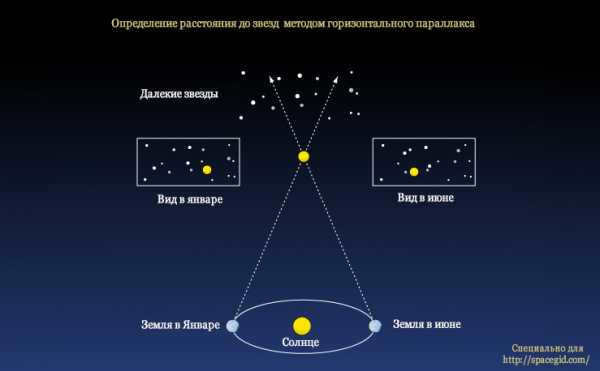
Parsec
A. Fizeau and L. Foucault conducted experiments using a rotating wheel and a mirror to observe the speed of light in a vacuum. These experiments allowed physicists to come closer to determining the true value of this measurement.
The precise measurement of the speed of light
In the past century, scientists successfully determined the precise speed of light. By utilizing Maxwell’s theory of electromagnetism, along with the assistance of advanced laser technology and calculations that accounted for the refractive index of light in the air, scientists were able to accurately calculate the speed of light to be 299,792.458 km/s. This value continues to be used by astronomers today. Additionally, scientists were able to calculate the distance of a light day, month, and year through straightforward calculations. The result was approximately 9.46 trillion kilometers, which represents the distance a beam of light would travel along the Earth’s orbit.
The distance between the Earth and the Moon is approximately 380,000 kilometers, which is equivalent to 4.108 light years. This means that a beam of light sent from Earth would only take about 1.3 seconds to reach the Moon. It’s interesting to note that one light-year is equal to 63,241.077 astronomical units and 0.306,601 parsecs.
- The center of the Milky Way Galaxy is located approximately 26,000 light years away from the Sun.
- It takes approximately 5 hours for sunlight to travel from the Sun to Pluto, which is one of the most distant objects in our solar system.
- Proxima Centauri, the second closest star to us after the Sun, is located approximately 4.2 light-years away from Earth.
- The closest galaxy to us, Andromeda, is located approximately 2.5 million light-years away.
The measurement of distances to stars is a challenging task due to their vastness. The commonly used unit of measurement, kilometers, is insufficient as even the distance from Earth to the Sun is an average of 150 million kilometers, and the distances to other planets are even greater. To overcome this, scientists use the concept of a light year, which represents the distance that light travels in one year. For even greater distances, the unit of measurement used is a parsec.
How Long is a Light Year?
Many individuals tend to confuse the Earth year with the concept of a light year. While an Earth year measures time – equivalent to 365 days, which is the time it takes for the Earth to complete one orbit around the Sun – a light year, on the other hand, is a unit of distance measurement.
A light year is a distance equal to 9,460,730,472,572,580,800 meters, which is the distance that a ray of light travels in one Earth year.
Given that the speed of light in a vacuum is constant and precisely known, it serves as an excellent means of measuring vast distances. There are also other units of measurement:
- 1 light second – 299,792.458 km
- 1 light minute – 17,987,547.48 km
- 1 light hour – 1,079,252,848.8 km
- 1 light day – 25,902,068,371.2 km
- 1 light week – 181,314,478,598.4 km
- 1 light month – approximately 790 billion km, as there is no precise value for the duration of a month.
These measurements equate to the distance covered by light traveling at a speed of approximately 300,000 km/s over a specific period of time – a second, a minute, and so on.
Thus, the Moon is situated 1.3 light seconds away from the Earth – that is the time it takes for a beam of light to reach the Moon from the Earth. The distance from the Earth to the Sun is 8 minutes and 20 light seconds. The Voyager spacecraft, which has exited the solar system, has journeyed a distance of 14 light hours.

What is the purpose of using light years?
If astronomers were to measure distances to other stars, nebulae, and galaxies in kilometers, these would be incredibly large values with numerous zeros. While it may work for the planets within our solar system, where distances are measured in the “mere” millions and billions of kilometers, it is not suitable for interstellar distances. It’s akin to using millimeters to measure distances between cities.
However, this is advantageous for distances within a galaxy, which, despite being immense, are comparatively small in relation to distances between galaxies. Take, for instance, the Andromeda galaxy, which resides in close proximity to us, yet is situated a staggering 2.5 million light-years away. And the further we venture into space, the greater the distances become, reaching into the billions.
Conversely, the concept of a “light-year” grants us a glimpse into the past. When we observe the Andromeda galaxy, positioned 2.5 million light years from our location, we witness it as it appeared 2.5 million years ago, not in the present moment. This is due to the fact that we have only just received the light emitted by this galaxy 2.5 million years ago. Consider a star situated 1000 light years away from us; it may undergo a supernova at this very moment, yet the light from the explosion will not reach Earth until a thousand years from now. For an entire millennium, we will continue to perceive the star as if it still exists.
However, our ability to observe the universe is limited to a distance of 13.8 billion light years. This restriction is based on the age of the universe, as an object that is located beyond this distance would have to be incredibly ancient.
A different unit of measurement
While the light year is a convenient way to measure cosmic distances, it has its limitations. This is why astronomers also use another unit of measurement called the parsec.
A parsec is equivalent to 3.26 light years, or approximately 30.8568 trillion kilometers.
The term “parsec” is derived from the words “parallax” and “second”. In practical terms, it represents the distance at which the radius of Earth’s orbit, which is about 150 million kilometers, appears to be one arc second in length. Through simple calculations, the length of the parsec can be determined.





